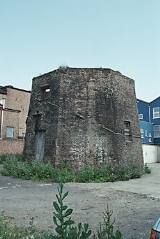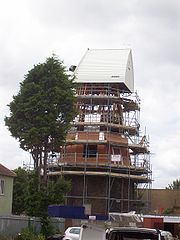
Great Mill, Sheerness
Encyclopedia
Great Mill or Ride' s Mill is a Grade II listed smock mill
just off the High Street in Sheerness
, Kent
, England
that was demolished in 1924, and now has a new smock tower built on it as residential accommodation.
Humphrey of Cranbrook
in 1813. Owing to the nature of the ground the mill was built on it was necessary to lay deep foundations. Lack of funds meant that the mill was left as an unfinished base for a couple of years before Thomas Webb, who owned the Little Mill, bought the unfinished mill and financed its completion in 1816. A steam engine
was added in 1889 as auxiliary power. The mill was worked by wind until 1905, when the sails and stage were removed. It worked by steam engine until 1918, and was demolished in 1924. The mill's brick base was left, serving as a corn store in the 1930s.
 In 2006, planning permission was applied for, and granted, to convert the existing mill base into a flat, with a new smock tower built on the base containing another flat, and an extension containing a third flat. Construction started late in 2006. The replica windmill will have a stage and dummy sails. The cap was lifted onto the mill tower late in 2007. On 23 January 2008 a fire started in the mill tower. The fire was later declared not to have been a case of arson
In 2006, planning permission was applied for, and granted, to convert the existing mill base into a flat, with a new smock tower built on the base containing another flat, and an extension containing a third flat. Construction started late in 2006. The replica windmill will have a stage and dummy sails. The cap was lifted onto the mill tower late in 2007. On 23 January 2008 a fire started in the mill tower. The fire was later declared not to have been a case of arson
.
. It was winded by hand, no fantail
being fitted. There was a stage at second floor level. The mill drove three pairs of millstone
s, and the steam engine drove a further two pairs, as well as the millstones in the windmill. The mill was 66 feet (20.12 m) high, and the brickwork in the base is 22 inches (558.8 mm) thick. The replica has a smock built on a steel frame, with a Kentish style cap.
Smock mill
The smock mill is a type of windmill that consists of a sloping, horizontally weatherboarded tower, usually with six or eight sides. It is topped with a roof or cap that rotates to bring the sails into the wind...
just off the High Street in Sheerness
Sheerness
Sheerness is a town located beside the mouth of the River Medway on the northwest corner of the Isle of Sheppey in north Kent, England. With a population of 12,000 it is the largest town on the island....
, Kent
Kent
Kent is a county in southeast England, and is one of the home counties. It borders East Sussex, Surrey and Greater London and has a defined boundary with Essex in the middle of the Thames Estuary. The ceremonial county boundaries of Kent include the shire county of Kent and the unitary borough of...
, England
England
England is a country that is part of the United Kingdom. It shares land borders with Scotland to the north and Wales to the west; the Irish Sea is to the north west, the Celtic Sea to the south west, with the North Sea to the east and the English Channel to the south separating it from continental...
that was demolished in 1924, and now has a new smock tower built on it as residential accommodation.
History
Work on building the Great mill was started by the millwrightMillwright
A millwright is a craftsman or tradesman engaged with the construction and maintenance of machinery.Early millwrights were specialist carpenters who erected machines used in agriculture, food processing and processing lumber and paper...
Humphrey of Cranbrook
Cranbrook, Kent
Cranbrook is a small town in Kent in South East England which was granted a charter in 1290 by Archbishop Peckham, allowing it to hold a market in the High Street. Located on the Maidstone to Hastings road, it is five miles north of Hawkhurst. The smaller settlements of Swattenden, Colliers...
in 1813. Owing to the nature of the ground the mill was built on it was necessary to lay deep foundations. Lack of funds meant that the mill was left as an unfinished base for a couple of years before Thomas Webb, who owned the Little Mill, bought the unfinished mill and financed its completion in 1816. A steam engine
Steam engine
A steam engine is a heat engine that performs mechanical work using steam as its working fluid.Steam engines are external combustion engines, where the working fluid is separate from the combustion products. Non-combustion heat sources such as solar power, nuclear power or geothermal energy may be...
was added in 1889 as auxiliary power. The mill was worked by wind until 1905, when the sails and stage were removed. It worked by steam engine until 1918, and was demolished in 1924. The mill's brick base was left, serving as a corn store in the 1930s.

Arson
Arson is the crime of intentionally or maliciously setting fire to structures or wildland areas. It may be distinguished from other causes such as spontaneous combustion and natural wildfires...
.
Description
Great Mill was a four storey smock mill on a two storey brick base, with a Kentish style cap carrying four patent sailsWindmill sail
Windmills are powered by their sails. Sails are found in different designs, from primitive common sails to the advanced patent sails.-Jib sails:...
. It was winded by hand, no fantail
Windmill fantail
A Fantail is a small windmill mounted at right angles to the sails, at the rear of the windmill, and which turns the cap automatically to bring it into the wind. The fantail was patented in 1745 by Edmund Lee, a blacksmith working at Brockmill Forge near Wigan, England, and perfected on mills...
being fitted. There was a stage at second floor level. The mill drove three pairs of millstone
Millstone
Millstones or mill stones are used in windmills and watermills, including tide mills, for grinding wheat or other grains.The type of stone most suitable for making millstones is a siliceous rock called burrstone , an open-textured, porous but tough, fine-grained sandstone, or a silicified,...
s, and the steam engine drove a further two pairs, as well as the millstones in the windmill. The mill was 66 feet (20.12 m) high, and the brickwork in the base is 22 inches (558.8 mm) thick. The replica has a smock built on a steel frame, with a Kentish style cap.
External links
- Windmill World page on the mill.

